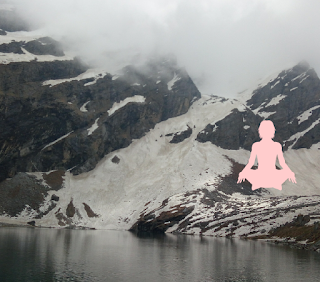Yoni Mudra: Mindfulness, Health; and etheric-astral space
One technique that can help you
connect and refine your perception and as well as help compose the mind is
Yoni-Mudra. Yoni- mudra is a Yogic hand gesture technique that represents
closing the six doors of perception- the eyes (count as 2), nose, mouth and
ears (count as 2); to enable the practitioner to disconnect with the outer
world and connect with inner-world. By allowing all five senses to focus inward,
the practitioner can have an experience of the chakras. The core component of
the yoni-mudra is to bring all the prana-energy into Ajna chakra. Ajna chakra
(brow) is a centre for extra sensory perception, will-power, self-control and
self-efficacy, all these are controlled by the pituitary gland which acts as a
command system for all other endocrine glands hence why pituitary gland is
known as the master gland. When the energy around the corresponding chakras in
the spine is being stirred or revived it gets stored within the chakra having
got attention; and through controlled action, brings wisdom, intuition and
filters the fog of uncertainties to reality. The mental process stops to an impeccable
silence and pure state of consciousness arises without any obstacle.
Mindfulness is the art of being
in the present movement and attunes us to the subtleties in our minds and in
our bodies and being provided firm roots for balancing prana energy and
provides strong root to seeker; resulting in correcting a number of physical
and emotional disorders promptly. When roots are deep within then there is no
reason to fear the storm of mental-physical disorders. Yoni mudra manifests
complete mindfulness.
Yoni- mudra Meditation:
Sit with legs crossed in a quite
comfortable place and close your eyes. Bring your attention to your breath,
breathing in and out naturally and just observe how your breath enters the body
and leave the body through the nostrils.
Place your both hands in front of
the face with the elbows pointed outward in the parallel with shoulders. Cover
your ears with the thumbs, and next, cover the eyes softly as touch the inner
corners of the eyes with the index fingers. Put the middle fingers on either
side of the nose nicely and ring fingers are being put above the mouth, and the
little fingers below the mouth.
Advance meditation-Breathe in
through nose slowly and unite Prana-vayu with Apana-Vayu (doing jalandhar Bandha
and mula bandha) in the navel area. Do Meditation on the six nerve centre (all
six chakras) with Om mantra and if possible do khichari mudra at the same time;
as the breath is quieted in the region from the throat to the third eye. A kind
of electric current will flow upward in the spine after some time. Exhale and
bring down the awareness along the spine to the root chakra. Repeat this five
times. With this mudra, one can attain Samadhi quickly.
Doing this for five to ten
minutes at night time before going to bed will provide better results and
observe inner sounds while of doing it. It helps to reconnect with the true
perception and make you able to perceive things better.
Mula Bandha: Sit in ‘Siddha asana’ or Padam
asana’. Contracting the perinea muscles (anus muscles), while a mental pressure
is exerted on the lower part of the spine and pulling up the apana Vayu by
contracting muscles and let to be meet both apana Vayu and Prana Vayu in the
navel area. This should be learned gradually.
Jalandhar bandha: Bend the head forward
so that the chin touches the pit below Adam ‘apple and the neck becomes a bit
stiff while back remains straight.
Khechari mudra: Placing
the tongue above the soft palate into the nasal cavity. In the beginning
stages, aspirant can place the tip of the tongue touches the soft palate as far
as possible or convenient without straining.



Nice 👍
ReplyDeleteGood
ReplyDeleteNice
ReplyDelete